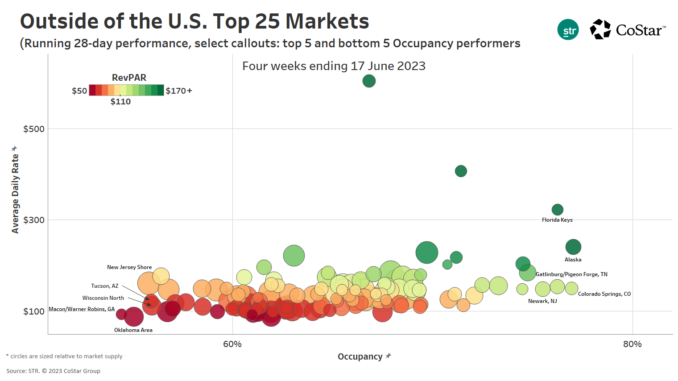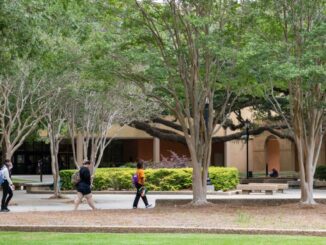

U.S. hotel industry performance slowed a bit more than expected in the four weeks ending 17 June 2023. That period, which spanned the slower business time around Memorial Day but also the start to the leisure-centered summer travel, produced flat demand and occupancy compared to the previous version of this “bubble chart” series. At the same time, gains in average daily rate (ADR) continued to level down.
Before diving into market specifics, it is important to note that one flat performance period does not signal an alarming trend. Recent demand trends have shown a healthy return, particularly in weekday/business travel. Still, we are reminded of the importance of continuing to monitor the industry with the context of with macroeconomic conditions, such as domestic vs. international travel, inflation and labor challenges.
Four weeks ending 17 June 2023:
- Occupancy came in at 66.0%, which was unchanged from the previous four weeks.
- Occupancy was down 1.9 ppts from the matching period in 2022.
- Occupancy was down 3.8 ppts from the 2019 comparable of 70.2%, a steeper deficit than last month’s long-term comparison (-3.1 ppts).
While the rate of new rooms in construction has flattened since the pandemic, it is worth adding that modest supply growth of 2.7% from the matched period in 2019 adds to that occupancy deficit against pre-pandemic times.
An added key reference to help frame this month’s mostly flat performance is to recall this point last year, when we observed an established surge in both leisure demand but also a remaining backlog of conventions/group bookings that particularly benefitted larger markets. In other words, recent benchmarks against last year face a bullish 2022 period when demand and ADR growth were more-or-less unbridled by broader industry/spending constraints.

The Top 25 Markets were led by New York City with a four-week average occupancy of 84.7%, which was a 1.6-ppt decline from the prior four weeks. Since mid-spring, New York’s winning margins have well-outshined other large markets with only recent signals that other large markets may be catching up. The next best occupancy markets were Oahu (81.3%, +3.0 ppts month over month), Boston (80.8%, +3.6 ppts), Las Vegas (79.1%, +0.6 ppts), and San Diego (78.3%, +5.2 ppts).
None of the Top 25 Markets matched their 2019 occupancy level for the four-week period, although there were close misses in San Diego (-0.3 ppts from 2019) and Phoenix (64.3%, -0.5 ppts from 2019). The steepest long-term deficits among large markets occurred in New Orleans (59.6%, -11.5 ppts from 2019) and San Francisco (-18.7 ppts from 2019). Additional notable deficits occurred in Minneapolis (63.2%, -6.9 ppts) and Detroit (64.4%, -4.7 ppts).
On an annual basis, the largest occupancy pickups among highlighted markets occurred in Oahu (+6.4 ppts YoY) and Boston (+3.6 ppts YoY). Coming off the surge of leisure travel in 2022, all larger Florida markets continued their occupancy deficits against last year. Moreover, two of the lower performing markets this month (New Orleans and Minneapolis) have lost notable ground since this period last year. This reflects a continuing struggle among select markets to replace last year’s pent-up demand with (more typical) convention and corporate travel.
In comparison, 52 of the 142 remaining STR-defined markets experienced occupancy gains above last year’s level, down from 57 markets in our last monthly update. In total, 41 of 167 markets posted better four-week average occupancy than 2019.
Yearly gains in ADR among Top 25 Markets are leveling down from prior “bubble” chart updates with 17 large markets (down from 21) seeing annual rate gains. Only eight markets, however, saw ADRs rise by 4%+ (ahead of the recent pace of inflation), including Detroit, New York City and Oahu.
In terms of a revenue per available room (RevPAR), 13 of the Top 25 Markets experienced YoY gains for the matched period, down from 21 markets last month. Oahu had the largest YoY RevPAR dollar gain, increasing $26 (+13.1%) to $228. New York City gained $20 RevPAR (+8.6%) YoY to reach $256.

Last month’s non-Top 25 market leader, Alaska, continued to lead medium-to-smaller markets with four-week 77.0% average occupancy (-5.3 ppts YoY). Next in line was Colorado Springs (76.9%, -3.1 ppts), the Florida Keys (76.3%, +3.1 ppts), Gatlinburg/Pidgeon Forge (76.2%, +3.0 ppts) and Newark (75.5%, +4.9 ppts).
Four in five (80%) small-to-medium sized markets saw YoY gains in their nominal ADR (non-inflation adjusted). When combined with occupancy performance, 11 markets experienced RevPAR growth in the double digits, down from 22 markets in our last monthly update. RevPAR overall grew in 88 markets beyond the Top 25, with growth matching/outpacing CPI-based inflation in just over half of those gaining markets.
This article originally appeared on STR.


Leave a Reply